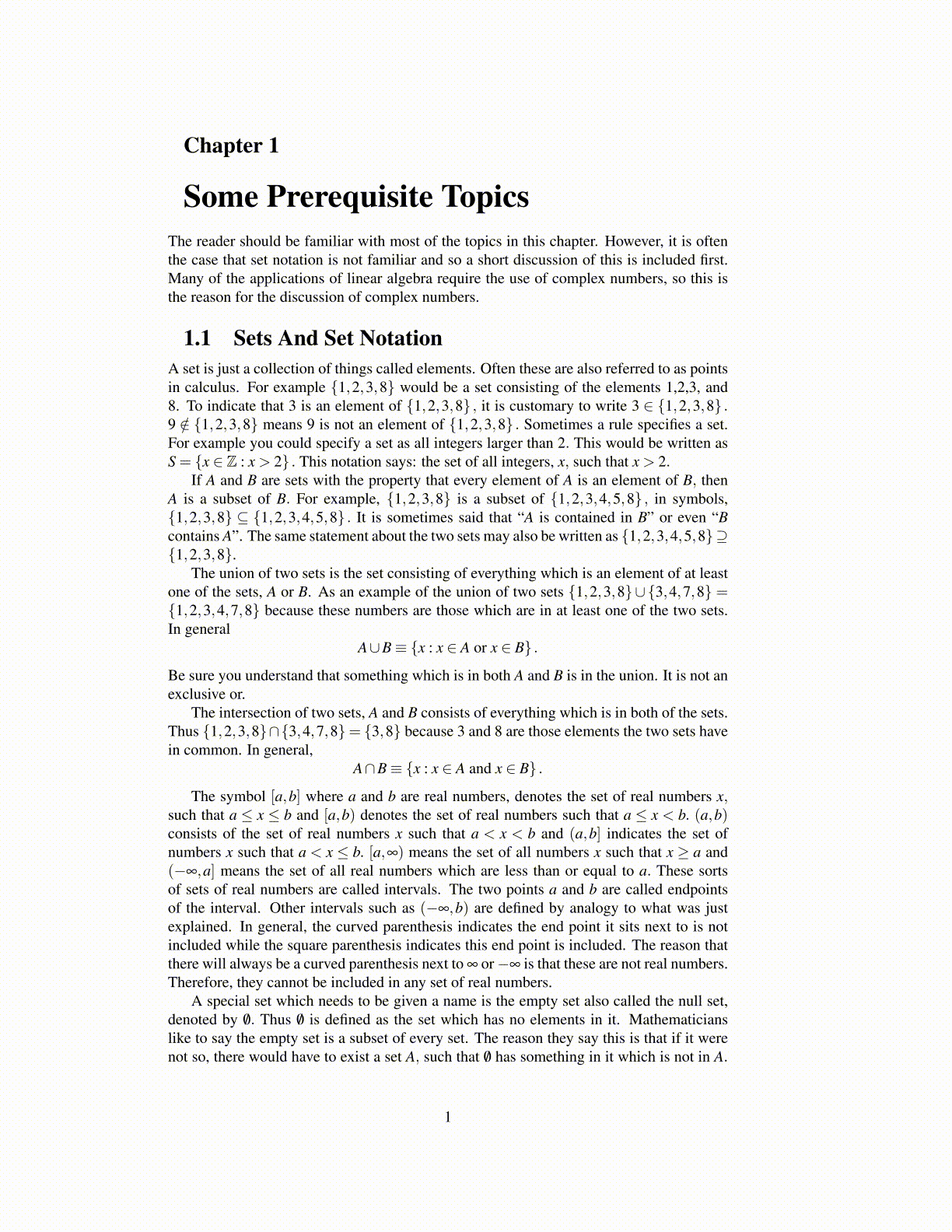
Chapter 1
Some Prerequisite TopicsThe reader should be familiar with most of the topics in this chapter. However, it is oftenthe case that set notation is not familiar and so a short discussion of this is included first.Many of the applications of linear algebra require the use of complex numbers, so this isthe reason for the discussion of complex numbers.
1.1 Sets And Set NotationA set is just a collection of things called elements. Often these are also referred to as pointsin calculus. For example {1,2,3,8} would be a set consisting of the elements 1,2,3, and8. To indicate that 3 is an element of {1,2,3,8} , it is customary to write 3 ∈ {1,2,3,8} .9 /∈ {1,2,3,8} means 9 is not an element of {1,2,3,8} . Sometimes a rule specifies a set.For example you could specify a set as all integers larger than 2. This would be written asS = {x ∈ Z : x > 2} . This notation says: the set of all integers, x, such that x > 2.
If A and B are sets with the property that every element of A is an element of B, thenA is a subset of B. For example, {1,2,3,8} is a subset of {1,2,3,4,5,8} , in symbols,{1,2,3,8} ⊆ {1,2,3,4,5,8} . It is sometimes said that “A is contained in B” or even “Bcontains A”. The same statement about the two sets may also be written as {1,2,3,4,5,8}⊇{1,2,3,8}.
The union of two sets is the set consisting of everything which is an element of at leastone of the sets, A or B. As an example of the union of two sets {1,2,3,8}∪{3,4,7,8} ={1,2,3,4,7,8} because these numbers are those which are in at least one of the two sets.In general
A∪B≡ {x : x ∈ A or x ∈ B} .
Be sure you understand that something which is in both A and B is in the union. It is not anexclusive or.
The intersection of two sets, A and B consists of everything which is in both of the sets.Thus {1,2,3,8}∩{3,4,7,8}= {3,8} because 3 and 8 are those elements the two sets havein common. In general,
A∩B≡ {x : x ∈ A and x ∈ B} .
The symbol [a,b] where a and b are real numbers, denotes the set of real numbers x,such that a ≤ x ≤ b and [a,b) denotes the set of real numbers such that a ≤ x < b. (a,b)consists of the set of real numbers x such that a < x < b and (a,b] indicates the set ofnumbers x such that a < x ≤ b. [a,∞) means the set of all numbers x such that x ≥ a and(−∞,a] means the set of all real numbers which are less than or equal to a. These sortsof sets of real numbers are called intervals. The two points a and b are called endpointsof the interval. Other intervals such as (−∞,b) are defined by analogy to what was justexplained. In general, the curved parenthesis indicates the end point it sits next to is notincluded while the square parenthesis indicates this end point is included. The reason thatthere will always be a curved parenthesis next to ∞ or−∞ is that these are not real numbers.Therefore, they cannot be included in any set of real numbers.
A special set which needs to be given a name is the empty set also called the null set,denoted by /0. Thus /0 is defined as the set which has no elements in it. Mathematicianslike to say the empty set is a subset of every set. The reason they say this is that if it werenot so, there would have to exist a set A, such that /0 has something in it which is not in A.
1